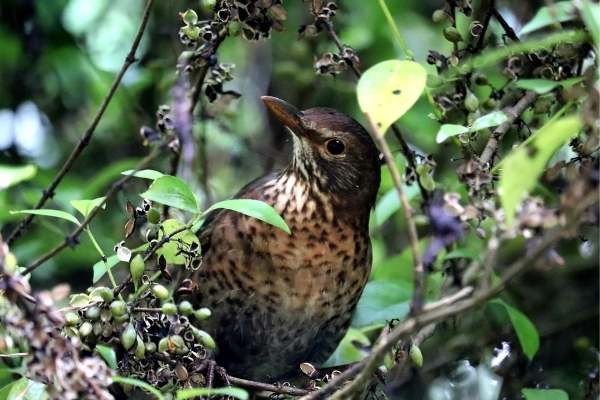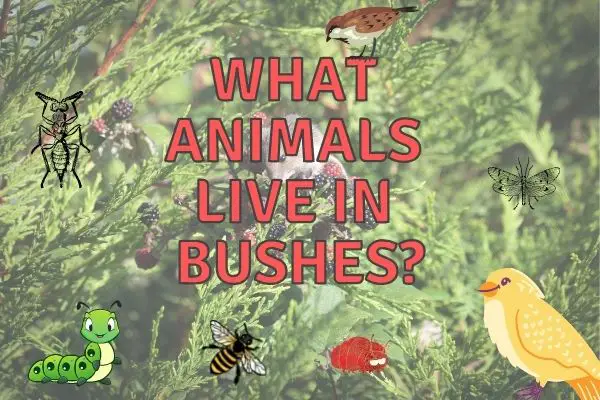There are many different animals that can be found living in bushes. Some of these animals are mammals, such as mice and other rodents, but most are insects and the birds that eat them!
Animals that can be found in bushes include caterpillars, spiders, beetles, flies, and other insects such as roaches and bees, but also reptiles such as lizards and snakes. Birds are also common inhabitants of bushes, with a variety of species such as sparrows making their homes in shrubs and hedges.
Shrubs and bushes are a type of vegetation that can be found in many different places, including forests, meadows, and backyards. They can be either small or large, and their size often depends on the climate and the amount of sunlight that they receive.
Bushes provide a perfect habitat for many animals, and the growth of bushes has been encouraged in some places to promote wildlife. The clearing of the brush has been discouraged, due to the damage that this causes to the many animals that live in bushes.
Many animals live in bushes and shrubs because they offer a variety of benefits. Any dense shrub provides food, shelter, and protection from predators. They also offer camouflage, which helps animals to avoid being seen by predators or the prey that they hunt themselves.
Whereas some animals build their homes and live most of their lives in bushes, shrubs and hedges, others just visit them to feed on the leaves or their other animal inhabitants.
Contents
What Animals Live in Hedges?
The use of hedges as a form of landscaping has become more popular in recent years. This is because hedges offer a number of benefits, including privacy, security, and wind protection.
Hedges are a type of shrub that is often used to define boundaries, and many animals may live there depending on the type of hedge.
When you think about it, a hedge is no more than a strictly controlled bush or shrub that is only allowed to grow within certain human-imposed boundaries.
Hedges can be either cared for or not – they can be either trimmed or left to grow naturally.

They can be either evergreen or deciduous. Arborvitae hedges are popular because they are evergreen and dense.
For this reason, arborvitae is eaten by many mammals including rabbits, dear, and squirrels, but they also house a variety of insects and even smaller birds.
Animals that live in many types of hedges but do not eat the leaves are spiders, lizards, hedgehogs, and many smaller birds such as sparrows, and blackbirds.
What Birds Live in Bushes?
Bushes offer a variety of benefits for birds, such as food, protection, and nesting spots. Many birds use shrubs to make their nests, using the vegetation to build a structure that can protect them from predators and harsh weather conditions.

They also provide a place where the young can grow, develop and forage.
Bushes and shrubs are also home to hundreds of different insect species including spiders, flies, and caterpillars, which birds can feed on.
There are many different types of birds that can be found in bushes, including sparrows, blackbirds, cardinals, and finches. Birds such as juncos, wrens, and finches also make their nests in bushes or other dense vegetation near the ground.
What Animals Live in Blackberry Bushes?
Blackberry bushes are nice if you want to eat blackberries. They produce berries that can be eaten not only by humans but also by many animals.
Animals that live in blackberry bushes include birds, mice, hedgehogs, and numerous insects.
Blackberry bushes also have thorns that protect not only their berries but also their animal inhabitants. In this way, Blackberry bushes can protect smaller mammals or birds against predators.
Other types of bushes with berries like Chokeberry, raspberries, red cedar, and hawthorn bushes also attract different animals like birds, squirrels, and other rodents.
Do Bees Live in Bushes?
Yes, bees are often found living in bushes because they offer a number of benefits. They can provide both food and protection for the young.
Many different types of flowers provide the nectar that bees feed on, but some species produce more nectar than others.
This is why bees may prefer to live in bushes with more flowers like Coralberry, Spicebush, Elderberry, or Blackhaw Viburnum are often chosen by bees over less flowering ones.
Do Flies Live in Bushes?
Yes, flies are often found living in bushes because they provide food and protection.
While the types of flies that live in bushes vary depending on what other species are present, just about all fly species will take advantage of the shelter offered by shrubs.
Flies also attract spiders and birds to the bushes, which regulates their numbers.
Do Hedgehogs Live in Bushes?
Hedgehogs are found living in numerous different habitats, including forests and grasslands, as well as backyards and homes.

They live just about anywhere that they can find dense ground vegetation for shelter and cover. This makes them common visitors of flowerbeds, bushes, and hedges.
Bushes and hedge plants recommended for attracting hedgehogs to your backyard are:
- Buckthorn
- Dog rose
- Hazel
- holly
- beech
- Goat willow
- Hawthorn
- Berberis
Do Bats Live in Bushes?
Yes, some types of bats are found in bushes and small trees because they offer food and shelter.
They can provide both food and protection for the young because they most often eat insects. However, some bats mostly eat fruit and will therefore stay in fruit trees and berry-producing bushes.
Mostly trees though, as they are taller and therefore protect better against predators from the ground.
Some bats, like the nectar bat, eat the nectar of flowers, which attracts them to flowering shrubs such as Honeysuckle, Moonflowers, Evening primrose, and Fleabane.
Most nectar-feeding bats tend to be most attracted to bushes and shrubs with purple, green, or white flowers.

Do Roaches Live in Bushes?
Yes, cockroaches are often found living in many different areas, including homes and backyards.
Roaches live just about anywhere that they can find food and water, which makes them attracted to human yards, and a bush or other vegetation provides nice shelter for cockroaches.
They can be either crawling or flying, and they can develop into large populations if they are not taken care of properly.
Do Bunnies Live in Bushes?
Bunnies or rabbits are found living in numerous different habitats, including grasslands, forests, and at the edges of bodies of water.
Whether rabbits are present in your backyard depends on your location, but if present in the area, they will likely seek out shrubs for food and shelter.
They can be found just about anywhere that they can find vegetation for shelter and cover. This makes bushes a common place where people will encounter rabbits.
However, wild rabbits do not live in bushes but in the tunnels that they dig underground.




